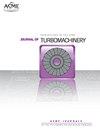径向水轮机多目标数值优化
IF 3.1
3区 工程技术
Q3 ENGINEERING, MECHANICAL
引用次数: 0
摘要
在涡轮增压器的应用中,对径向涡轮的高灵活性和宽工作范围的要求越来越高,这就要求在涡轮机械的设计过程中采用新的方法。通常,在某些工作条件下的高性能或低惯性等设计标准与高耐久性的要求相矛盾。本文展示了一种新开发的径向涡轮机优化方法,该方法允许对几个设计目标进行优化。提出的方法是基于涡轮几何参数化模型。一方面,该模型旨在捕捉最重要的几何形状和设计特征,另一方面,它可以灵活地用于各种机器。基于代理模型的遗传算法用于优化几何形状,包括效率、耐久性(HCF)、低周疲劳(LCF)、惯性和质量等几个目标。可以特别强调某些操作点或标准,并在整个过程中指定约束,以便进行定制优化。优化背后的模拟是最先进的CFD和FE分析,涉及各自的组件。新开发的全自动化方法包括不同学科的任务。最后,对几种有前途的几何形状进行了更密切的检查,以最终找到最适合给定应用的几何形状。在目前的研究中,这种几何形状已经制造出来,并在热气体测试设备上进行了测试,以成功验证设计过程。本文章由计算机程序翻译,如有差异,请以英文原文为准。
MULTI-OBJECTIVE NUMERICAL OPTIMIZATION OF RADIAL TURBINES
Abstract The growing demand of high flexibility and wide operating ranges of radial turbines in turbocharger applications necessi- tates new methods in the turbomachinery design process. Of- ten, design criteria such as high performance at certain operat- ing conditions or low inertia contradict the requirement for high durability. This paper demonstrates a newly developed optimiza- tion approach for radial turbines that allows to optimize for sev- eral design objectives. The presented approach is based on a parametric model of the turbine wheel geometry. On the one hand, the model is designed to capture the most important geometry and design features, and on the other hand, it is flexible for use on various machines. A surrogate model-based genetic algorithm is used to optimize the geometries with respect to several objectives, including efficiency, durabil- ity (HCF), Low-Cycle Fatigue (LCF), inertia and mass. Certain operating points or criteria can be particularly emphasized and specified constraints throughout the process allow for customized optimization. The simulations underlying the optimization are state-of-the-art CFD and FE analyses, involving the respective components. The newly developed and fully automated approach includes tasks of different disciplines. In the end, a selection of several promising geometries is examined more intimately to finally find a most suitable geometry for the given application. For the cur- rent study, this geometry has been manufactured and tested on a hot-gas-test facility to successfully validate the design process.
求助全文
通过发布文献求助,成功后即可免费获取论文全文。
去求助
来源期刊
CiteScore
4.70
自引率
11.80%
发文量
168
审稿时长
9 months
期刊介绍:
The Journal of Turbomachinery publishes archival-quality, peer-reviewed technical papers that advance the state-of-the-art of turbomachinery technology related to gas turbine engines. The broad scope of the subject matter includes the fluid dynamics, heat transfer, and aeromechanics technology associated with the design, analysis, modeling, testing, and performance of turbomachinery. Emphasis is placed on gas-path technologies associated with axial compressors, centrifugal compressors, and turbines.
Topics: Aerodynamic design, analysis, and test of compressor and turbine blading; Compressor stall, surge, and operability issues; Heat transfer phenomena and film cooling design, analysis, and testing in turbines; Aeromechanical instabilities; Computational fluid dynamics (CFD) applied to turbomachinery, boundary layer development, measurement techniques, and cavity and leaking flows.

 求助内容:
求助内容: 应助结果提醒方式:
应助结果提醒方式:


